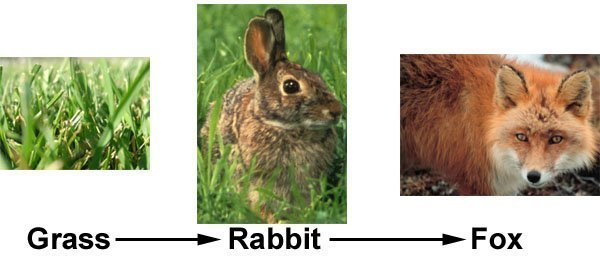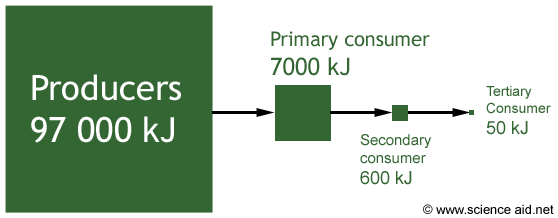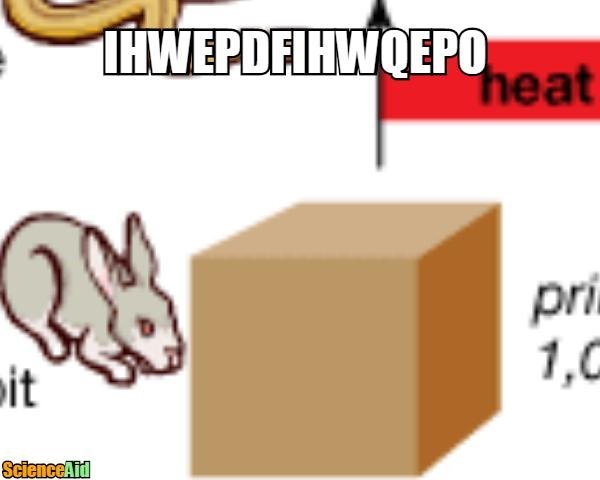Food and Energy: Energy Transfer and Ecological Pyramids
Edited by Jamie (ScienceAid Editor), Jen Moreau, Carlos Spicy Wiener, SarMal and 7 others
You've probably studied food chains since primary school and are familiar enough with the concept to differentiate between herbivores and carnivores to identify those species at the top of the food chain and those species on the bottom. These concepts are the rudimentary basics of the food chain, however, food chains can be much more intricate and are undoubtedly vital parts of our ecosystems. As the name implies, food chains link the consumption of food, the amount of energy wasted and the transfer of energy amongst a species. Food chains always start with a plant source and always end with an animal. A simple example of a food chain would be: a plant is consumed by a herbivore, the herbivore is then consumed by a carnivore. Seems pretty simple right? It is, but there are many more links and transference of energy depending on the food chain.
- 1 Food Chains
- 2 Energy Transfer
- 3 Ecological Pyramids
-
4 Questions and Answers
- 4.1 How does energy transfer through the number, energy, and biomass pyramids?
- 4.2 Why is the energy conversion factor different for Caterpillar (5.5 kcal/g) vs. the food (4.35 kcal/g)?
- 4.3 How much energy is lost to get food in the food pyramid? And how much energy is gained?
- 4.4 What does most of the energy from food get used for?
- 4.5 What amount of energy is used in each phase of the food web?
- 4.6 Why are there fewer numbers of organisms moving up the pyramid than there are in the preceding levels?
- 4.7 How much energy transfers to each after it eats the other?
- 4.8 To study feeding relationship between dogs to fleas, would it best to use a pyramid of numbers or a pyramid of energy flow?
- 5 Referencing this Article
- 6 Comments
Food Chains
A typical food chain looks like this:
A food chain the transference of energy between organisms through consumption, in this case, the rabbit is eating grass and the fox is eating the rabbit.
The initial energy source is found in the plant. The plant uses initial energy from the sun to convert into chemical energy via photosynthesis. The herbivores eat the plants, ingesting some of the energy from the plant of the energy. The herbivore then becomes prey their energy is transferred to the predator.
When consumed some of the energy is transferred but some of the energy is lost at each link in the chair (or trophic level). In the above example, the grass loses some energy by respiration, the rabbit loses energy by heat and waste. By the time the energy is transferred to the fox, there is only a fraction of the total energy transferred.
Energy Transfer
In each ecosystem, it is energy, that enables organisms to live. This energy mainly comes from one original source: photosynthesis. The plants in the ecosystem use this solar energy to produce carbohydrates which are then consumed by other organisms: transferring the energy.
Not all of the energy from sunlight, however, is used by the plants solely as energy; they are far from efficient. A lot of sunlight misses the plant, is in the wrong wavelength or lost in the inefficiencies of photosynthesis. We use the term gross primary production to refer to the total energy in the molecules of the plant; net primary production is the surplus energy not used by the plant itself.
At each level of the food chain energy is lost because it is used by the organism itself for respiration. This limits the number of steps there can be in a food chain.
The diagram above represents quantitatively (in numbers) the efficiency of energy transfer in a food chain. Notice that only about 8% of the energy is transferred from one stage to the next.
Ecological Pyramids
A food chain is represented quantitatively (with numbers) in the form of a pyramid of a number. Listed below is a quantitative representation of the previously presented food chain. From this graph, we can see there are fewer foxes than rabbits; which makes sense because a fox must eat several rabbits to get enough energy in order to survive.
An ecological pyramid shows the relative sizes of different components at the various trophic levels of a food chain. A trophic level refers to each stage (shown as a horizontal bar on ecological pyramids). There are three types of ecological pyramid we use: numbers, biomass and energy.
The pyramids of numbers show the raw number of each species at each trophic level. The top example is a typical food chain with a large number of producers but diminishing numbers of consumers. However, if the producer was a tree, followed by insects, then the bottom bar would appear small as many organisms feed on one tree. In this instance, the pyramid of biomass is more useful as the tree is much larger.
In the lower example, both the pyramid of numbers and biomass show a smaller producer bar; given what was discussed under the previous heading - this does not make sense. This is because the phytoplankton reproduces very quick. However, when we represent this information in a pyramid of energy we get a true pyramid.
Plotting the energy will always give a true pyramid because it is impossible to create new energy. A trophic level will always be smaller than the one below it.
The picture of grass in the first graphic was taken by Catarina Carvalho and taken from wikimedia commons
Questions and Answers
How does energy transfer through the number, energy, and biomass pyramids?
How does the energy transfer through all these pyramids. The article doesn't say how energy transfer through number, energy, and biomass pyramids
Energy is transferred through the pyramid by consuming something with energy. The source is the sun. photosynthesizers store this energy by forming chemical bonds as carbohydrates. When these carbohydrates (chemical bonds) are consumed, the energy stored in the bond is released and processed metabolically through respiration. This can be either aerobic, fermentative, or anaerobic.
Look at other Q&A posted on this page for more info relating to energy pyramids.
Why is the energy conversion factor different for Caterpillar (5.5 kcal/g) vs. the food (4.35 kcal/g)?
I had to calculate the energy for both the caterpillar and food in my experiment
Please see the article Calculating the Transfer of Energy Between Trophic Levels for an explanation on energy conversion and calculating the energy transfer.
How much energy is lost to get food in the food pyramid? And how much energy is gained?
Food pyramid for 10 Grade Biology. Please help, it is for a study guide for the end of the year test.
The source of energy that drives the food chain is the sun. Plants and other photosynthesizers can incorporate the sun's energy by the chemical bonds it forms in carbohydrates like glucose. Each trophic level in the energy pyramid obtains a logarithmic reduction in energy as you go up the pyramid. This means that the lowest (first) trophic level, for instance, supplies 10^4 (which is 10,000) kcal of energy. Kilocalories (kcal) is the unit of measure for metabolic energy. Moving to the second trophic level, only 10^3 kcal is provided. The third trophic level would provide 10^2 kcal (which is 100); the fourth is 10^1 kcal (or 10). Energy appears to be "lost." That is not the case. Through metabolic processes, the energy is transferred to the environment as heat. Energy is also required to break down food (chemically) and turn it into usable energy. This happens in the Krebs, or TCA cycle in the mitochondria. Even bacteria expend 60% energy in metabolic processes when degrading (consuming) substances like plant litter (glucose).
The loss of energy up the food chain is why higher trophic levels must eat much more food than lower trophic levels. This is also why food chains are usually limited to no more than 6-8 trophic levels. I'm sure you realize that bunnies eat much less food than buzzards or lions. Also, because bunnies are getting food from the highest energy containing source, they don't need to eat as much to get the same equivalent energy.
What does most of the energy from food get used for?
Most of the energy that is lost during energy transfer is lost to heat. However, the energy gained through food is used for a variety of different things including respiration, brain function, and to fuel the metabolic function of organs and tissues.
What amount of energy is used in each phase of the food web?
I'm currently in science class doing a project on ecology and I need to give info on the amount of energy used in each phase of the food web please help due the 18th
As food is passed along roughly 10% is transferred to the next level. Example, 10% of energy phytoplankton from the sun can be used by zooplankton at the next level. About 90% of the energy is lost by the previous level. Meaning there must be many more organisms at the lower level than at the higher levels. This energy loss is easier to understand by looking at a food pyramid.
Amount of Biomass passed up the Food Pyramid ""(In pounds)""
- 1 PERSON
- 10 LARGE FISH
- 100 SMALL FISH
- 1,000 ZOOPLANKTON
- 10,000 PHYTOPLANKTON
Why are there fewer numbers of organisms moving up the pyramid than there are in the preceding levels?
Why are there fewer numbers of organisms moving up the pyramid.
You can find this answer in the article Ecosystem and Its Components
How much energy transfers to each after it eats the other?
When the rabbit eats the grass how much energy does it get? How much energy does the fox get when it eats the rabbit?"
Please see the article Calculating the Transfer of Energy Between Trophic Levels for an explanation on energy conversion and calculating the energy transfer.
To study feeding relationship between dogs to fleas, would it best to use a pyramid of numbers or a pyramid of energy flow?
To study feeding relationship between dogs to fleas, would it best to use a pyramid of numbers or a pyramid of energy flow. this question is related to ecological . this question is related to ecological pyramidthis question is related to ecological pyramidthis question is related to ecological pyramidthis question is related to ecological pyramidthis question is related to ecological pyramidthis question is related to ecological pyramidthis question is related to ecological pyramidthis question is related to ecological pyramidthis question is related to ecological pyramidthis question is related to ecological pyramidthis question is related to ecological pyramidthis question is related to ecological pyramidthis question is related to ecological pyramidthis question is related to ecological pyramidthis question is related to ecological pyramid. I don't understand what the question is asking and I don't how to word it so help please and thank you
ScienceAid QnA. This section is not written yet. Want to join in? Click EDIT to write this answer.
Referencing this Article
If you need to reference this article in your work, you can copy-paste the following depending on your required format:
APA (American Psychological Association)
Food and Energy: Energy Transfer and Ecological Pyramids. (2019). In ScienceAid. Retrieved Apr 25, 2024, from https://scienceaid.net/biology/ecology/food.html
MLA (Modern Language Association) "Food and Energy: Energy Transfer and Ecological Pyramids." ScienceAid, scienceaid.net/biology/ecology/food.html Accessed 25 Apr 2024.
Chicago / Turabian ScienceAid.net. "Food and Energy: Energy Transfer and Ecological Pyramids." Accessed Apr 25, 2024. https://scienceaid.net/biology/ecology/food.html.
If you have problems with any of the steps in this article, please ask a question for more help, or post in the comments section below.
Comments
Article Info
Categories : Ecology
Recent edits by: dh;akenn aegn, MaxScience, the b whom wants a reply in 1 second











